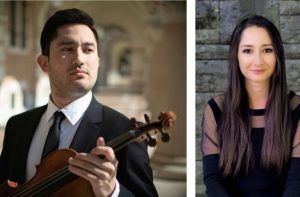
By Robert Croan
FORT LAUDERDALE – The South Florida Symphony Orchestra, having completed its regular season, is brightening up this year’s already long, hot summer, with a series of three chamber music concerts, each held in Fort Lauderdale’s Center for Spiritual Living and at Temple Israel of Greater Miami.
The second of these, seen June 24 in Fort Lauderdale, featured the brother-sister duo of violinist Askar Salimdjanov and pianist Tamila Salimdjanova, young artists from Uzbekistan, who have already won prestigious awards and competitions.
The recital, which featured sonatas by Mozart and Richard Strauss, followed by lighter works based on operas by Gershwin and Bizet, was also something of a preview of the orchestra’s 2022-23 opening concert in Fort Lauderdale’s The Parker (formerly the Parker Playhouse), for which violinist Salimdjanov will return Nov. 9 as soloist in Tchaikovsky’s Violin Concerto.
The meat of the program was Strauss’s Sonata (in E-flat, Op. 18), written in 1887 when the composer was 23, and premiered the following year. Its style is not yet distinctive of the mature Strauss – his earliest major tone poem, Don Juan, was yet to come, and his first important opera, Salome, was two decades into the future – but rather a summing up of what the composer had learned from studying and playing the then-standard repertory of the mid-19th-century Romantic school. The most notable influence is that of Brahms, but occasional lighter moments hark back further to Mendelssohn and even Schubert.
On its own, however, Strauss’s Violin Sonata is a thoroughly enjoyable, satisfying and well-crafted opus, in which the virtuoso violin part shares equal honors with the dense and intense, often-voluminous keyboard writing. One way that Strauss’s sonata is advanced over some of his recent predecessors is in the equality between the instruments. The piano is every bit as important as the violin, and the Salimdjanov siblings made it a genuine collaboration.
From the opening keyboard chords, Tamila’s playing was commanding, full-toned but also lyrical, with a sense of Strauss’s long-lined phrases and also, when called for, a touch of rippling Mendelssohnian lightness to balance the work’s overall passion and gravitas. The piece was, more than incidentally, an ode in sound to the singer Pauline de Ahna, who would eventually become the composer’s wife.
In this regard, the reposeful middle movement, an Andante cantabile described in the score as an “improvisation,” (and quickly to become an excerpted entity on its own) gave the artists an opportunity to show their own lyrical sensitivities. The final Allegro brought back the bravura, with a no-holds barred ending that brought the audience to its feet.
The program had begun with a Mozart violin-and-keyboard sonata (No. 21, K. 304) that – typical of Mozart works in this genre – gave more to the piano than the violin. It was a wistful piece in the key of E minor, unusual for Mozart in his instrumental works, possibly explained by its having been written around the time of his mother’s death. It served as an agreeable warm-up.
The evening’s real fireworks, however, came after intermission: two operatic fantasies intended primarily to astonish, and here the violinist was completely at the fore, fully up to all the technical challenges. First was Concert Fantasy on Themes from Gershwin’s ‘Porgy and Bess,’ arranged by Russian violinist Igor Frolov in 1991. It exploits the sadness of “My man’s gone now” at the start, imparting to most of the popular hit tunes an intriguing individual twist.
The showpiece, however, was Franz Waxman’s Carmen Fantasie, a dazzling virtuoso showpiece written with Jascha Heifetz in mind for the 1946 movie, Humoresque. As it happened, it was the young Isaac Stern, not Heifetz, who performed in the film, but it became a showpiece for Heifetz as well, eventually replacing in the violin repertory an older fantasy on Bizet’s Carmen by Sarasate.
Curiously, neither Waxman nor Sarasate included the “Toreador” Song – one of classical music’s most widely recognizable tunes – nor, for that matter, Micaëla’s melodic Act 3 aria, in their arrangements.
As anticipated, the Salimdjanovs’s Carmen rendition brought the recital to a crowd-pleasing conclusion.